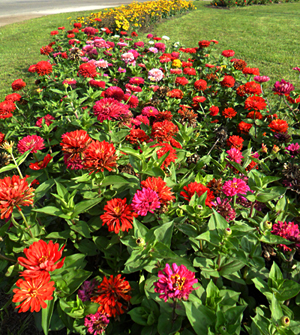Green Infrastructure—Part of The Conservancy’s Past, Present and Future
Green infrastructure is the network of designed and natural vegetation found in cities and towns. It includes public parks, recreation areas, remnant vegetation, residential gardens and street trees as well as innovative and emerging new urban greening technologies. It highlights the importance of the natural environment in decisions about land-use planning.

A community garden near Rankin Bridge.
Although the term originated in the U.S. in the mid-1990s, WPC began doing green infrastructure work in 1940 when it undertook its first hands-on project. The Conservancy’s green infrastructure work has continued over the years, with a number of new projects initiated during the past five years.
WPC has maintained community green spaces since 1972, and facilitated creation of food gardens in the early 1980s in response to the region’s economic downturn. As the economy improved, the emphasis moved towards flower gardens.
Community Gardens: WPC’s most widespread green infrastructure work involves the nearly 135 flower gardens it maintains in 20 counties throughout the region with the help of nearly 13,000 volunteers. Many sites were once neglected vacant lots.
Urban Forestry: Since 2008, WPC has led efforts to plant nearly 15,000 trees in the greater Pittsburgh region (see article, p. 10-11). To date, nearly 3,800 volunteers and 60 groups from 57 communities have joined the effort to plant trees along streets and trails and in parks and schoolyards.
Hanging Baskets: From spring to fall, more than 700 hanging baskets enhance downtown Pittsburgh’s streets and bridges and seven neighborhoods. This project began in 1999 with a startup grant from the Grable Foundation, and is now funded by the Laurel Foundation.
Planters: For the fifth consecutive year, more than 400 planters filled with evergreens and seasonal blooming plants have lined various downtown Pittsburgh streets, thanks to funding from the Colcom Foundation.
School Grounds Greening: Grable Foundation support has allowed WPC to work with more than 50 Pittsburgh public schools since 2009 to create plantings and outdoor green spaces, bringing children closer to nature.
Other Recent Green Infrastructure Projects: WPC has undertaken a variety of smaller projects to demonstrate other types of green infrastructure, including installation of bioswales and Silva Cell trees. Other recent projects include:
Green wall: The Conservancy installed a vertical garden on the side of a building on Seventh St. in downtown Pittsburgh this summer. In addition to their pleasing appearance, the trellis vines will shade the building in hot weather, reduce wind chill during winter and absorb rainwater.
Rain garden: WPC installed a rain garden in 2011 at the environmentally friendly Sanguini baseball field in Pittsburgh’s Brighton Heights to assist with challenging hydrologic conditions caused by the property’s steep slopes. The project was in partnership with Heinz Endowments and Pittsburgh Pirates Charities. A large rain garden was also placed at Allderdice High School in Squirrel Hill.
